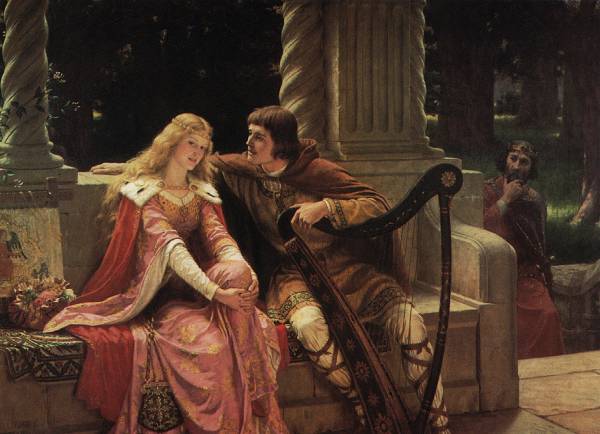
... no knight can be brave unless he is in love, love gives the knight his courage.
Now that his armor was clean, his helmet made into a complete headpiece, a name
The highest glory of any knight was to be worthy of the love of the lady he desired.



-Lecoy de la Marche, A. La Charre francaise au moyen age
found for his horse, and he confirmed in his new title, it struck him that there was
one more thing to do: to find a lady to be enamoured of. For a knight errant without
a lady is like a tree without leaves or fruit and a body without a soul.
-Cervantes, Don Quixote
-Charles Moseley, The Origins of Wisdom, Chivalry

The Doctrine of love

It has been said of the age of chivalry that no higher ideal of sexual relations has ever been put foward
than that which the best of the knights professed and practised. However, the first chivalric knights, the
Christian Crusaders, were strictly devoted to their church and to the concept of noble warfare, leaving
themselves little time for the worship of fair ladies. Gradually, a new doctrine began to evolve, a
doctrine of gallantry which considered itself equal, if not superior to both war and religion as a vehicle
of chivalric conduct.Influence of the east
From the outset, the church remained suspicious of the code of gallantry which infiltrated Christian
chivalry, believing it distracted the knight from the worthier task of rescuing the Holy Land from the
infidel. The church proved powerless to prevent gallantry from establishing itself securely as a crucial
element of chivalry. The repeated journeys made from Europe to the Holy Land in the name of the
Crusades had the effect of introducing knights to the unfamiliar customs of other nations. In Eastern
Christendom they discovered a respect for women they were unaccustomed to in the West. In
Constantinople they found the splender of Eastern luxury and a great love of ceremony. In Arab society,
which was strongly influenced by the Persians, they encountered a more spiritual union between man
and woman, together with a passion for music and poetry. Many knights came to appreciate what
they saw and carried these influences back to Western Europe with them.Role of the troubadour
The spirit of Arabic love poetry filtered up through Spain, still largely Moslem, to the Christian states
of Catalonia, Aquitaine and Provence in Southern France. It found receptive audience in a society
that already admired the witty love poetry of the Roman poet Ovid. The combination of these two
strands, and the resulting interest in the psychology of love and the ironies of the situation of lover
and beloved, the one dying of desire and the other unattainably, almost divinely, aloof, framed the
new poetry of Europe. The driving force of this art was the virtue of selfless service and courtesy to
ladies and women, what the German minnesingers called Frauendienst, mixed with exagerated, yet
enchanting accounts of the chivalric exploits of knights at war. The troubadours, a breed of minstrel-
soldier responsible for the spread of this new poetry, began to flourish as a species, having major
effect on the evolution of social manners throughout Europe and the subsequent development of all
European lyric poetry.As the twelfth century progressed, knights errant and troubadours were welcome everywhere. Poetry
became the favorite pastime of the age, and a form of brotherhood evolved which considered all poets
equal, regardless of birth. The art of composition was practised by kings, knights and ladies, as well
as by professed poets and wandering minstrels.Elevation of women
When the turmoil of the early Crusades had died down and knights began to spend less time on the
battlefield, women increasingly provided the focus for their attentions. A state of relatively military calm,
coupled with the rise of troubadour poets, dictated that the feminine graces were no longer overlooked
and women soon exerted a power over the knight as powerful as his religion. The highest glory of any
knight was to be worthy of the love of the lady he desired. To this end, the most impressive acts of valor
were performed and the most romantic adventures undertaken, in fiction at least, and to some extent in
reality. Such a development in attitudes towards women was quite remarkable as compared to the
earlier feudal period, when women were considered almost a burden; when marriage existed for the
purposes of financial gain and women were simply delivered over to the highest bidder. Now women
were the guiding lights of chivalry and the home evolved as a center of social intercourse, promoting the
civilizing arts of music, poetry, painting and sculpture.Court of Love
One of the remarkable developments of the twelfth century and later is the amount of time and space
given to discussions of the ethics, and aesthetics of relationships. There was already an interest in the
psychology of love; and this developed into court games, such as 'Courts of Love', in which the niceties
of behavior and morality might be discussed, often exploring the hypothetical situations set out in
fashionable fiction, especially the newly popular romance form.Nature has a way of imitating art, and there is no doubt that such discussions and controversies round
such ideals affected behavior and conduct. Indeed, there is little doubt that the insistence on gallantry,
on courtesy, on deference to the lady as the fount of honor, made many a marriage contracted for purely
political reasons more tolerable for both parties than would otherwisw have been the case. It may be
that, as often happens, what was pretended determinedly enough came to be, infact, true.


a n @ m i c r o n . n e t URL https://members.tripod.com/~aaron_neilson/romance.html